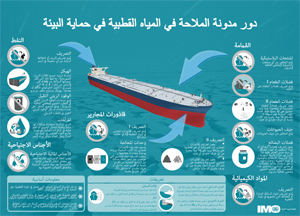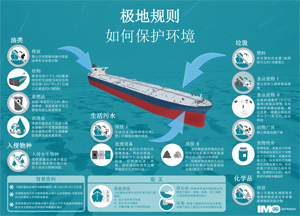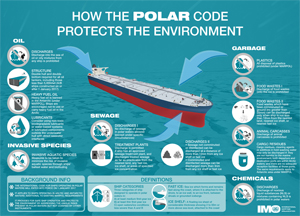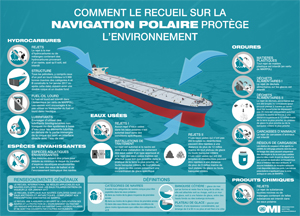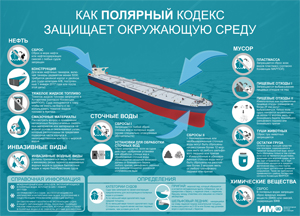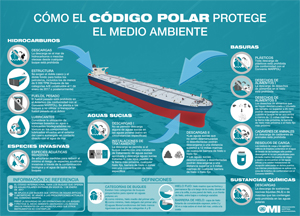Shipping in polar waters
International Code for Ships Operating in Polar Waters (Polar Code)

IMO's International Code for Ships Operating in Polar Waters (Polar Code) is mandatory under both the International Convention for the Safety of Life at Sea (SOLAS) and the International Convention for the Prevention of Pollution from Ships (MARPOL). The Polar Code covers the full range of design, construction, equipment, operational, training, search and rescue and environmental protection matters relevant to ships operating in the inhospitable waters surrounding the two poles. The Polar Code entered into force on 1 January 2017.
|
IMO in the polar environment: The Polar Code explained |
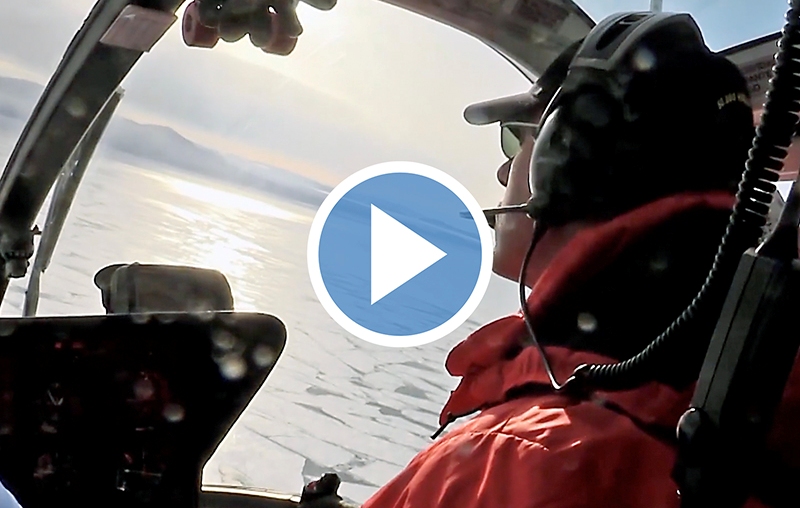
IMO in the polar environment: Search and Rescue |
The Polar Code and SOLAS amendments were adopted during the 94th session of IMO’s Maritime Safety Committee (MSC), in November 2014; the environmental provisions and MARPOL amendments were adopted during the 68th session of the Marine Environment Protection Committee (MEPC) in May 2015.
What does the Polar Code mean for ship safety?
The following infographic illustrates the safety requirements of the Polar Code - available to view and download:
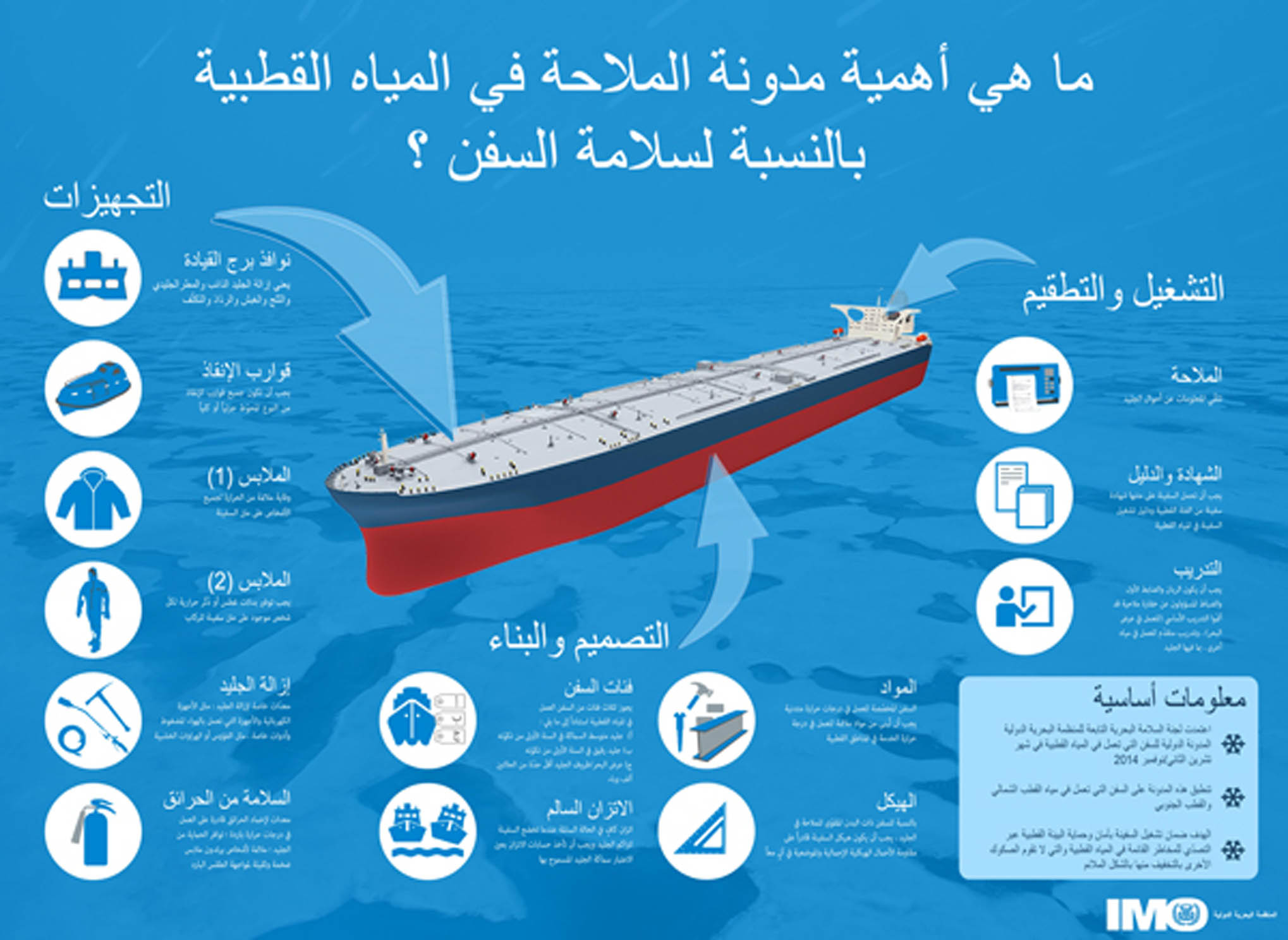 Arabic |
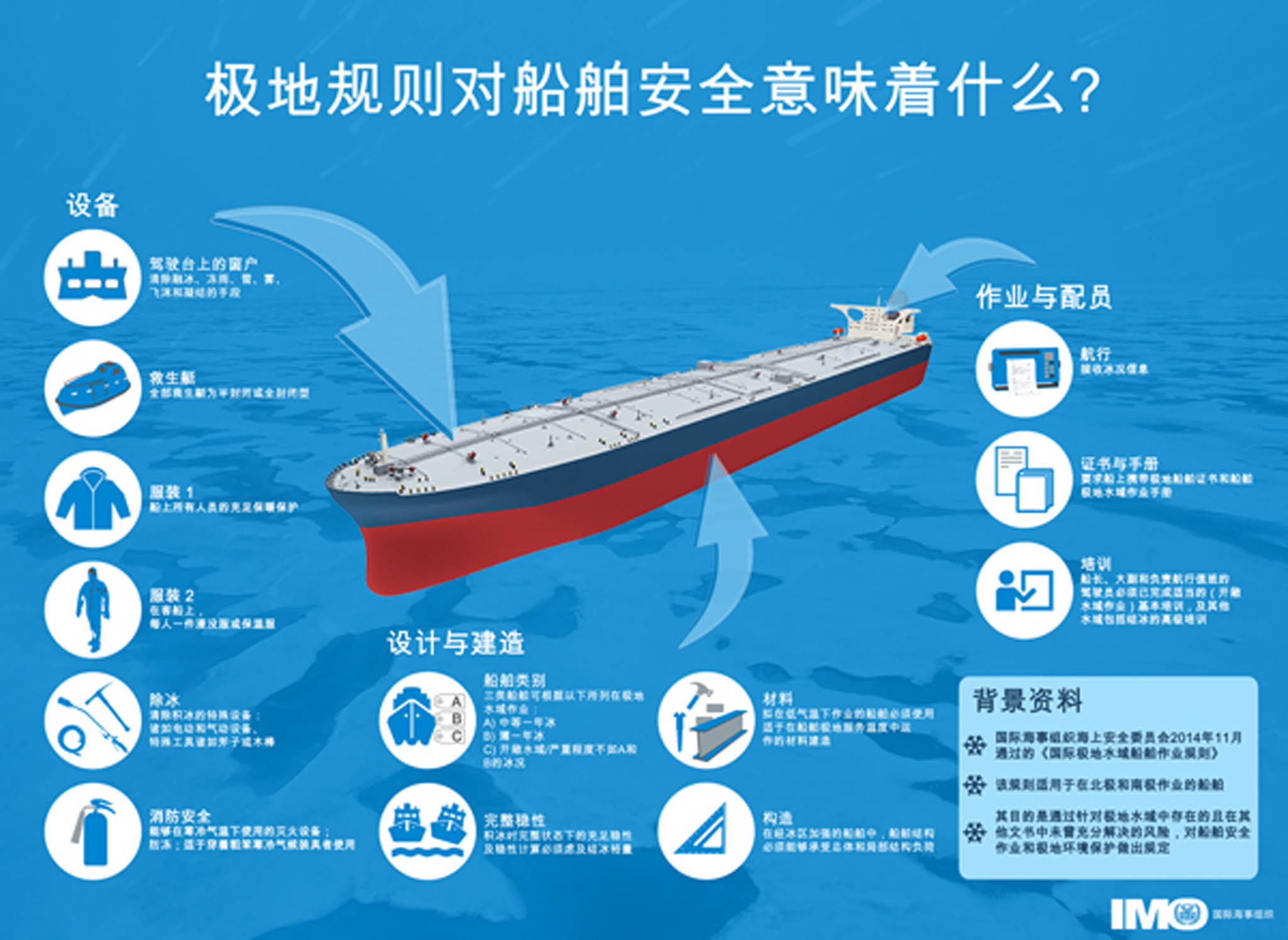 Chinese |
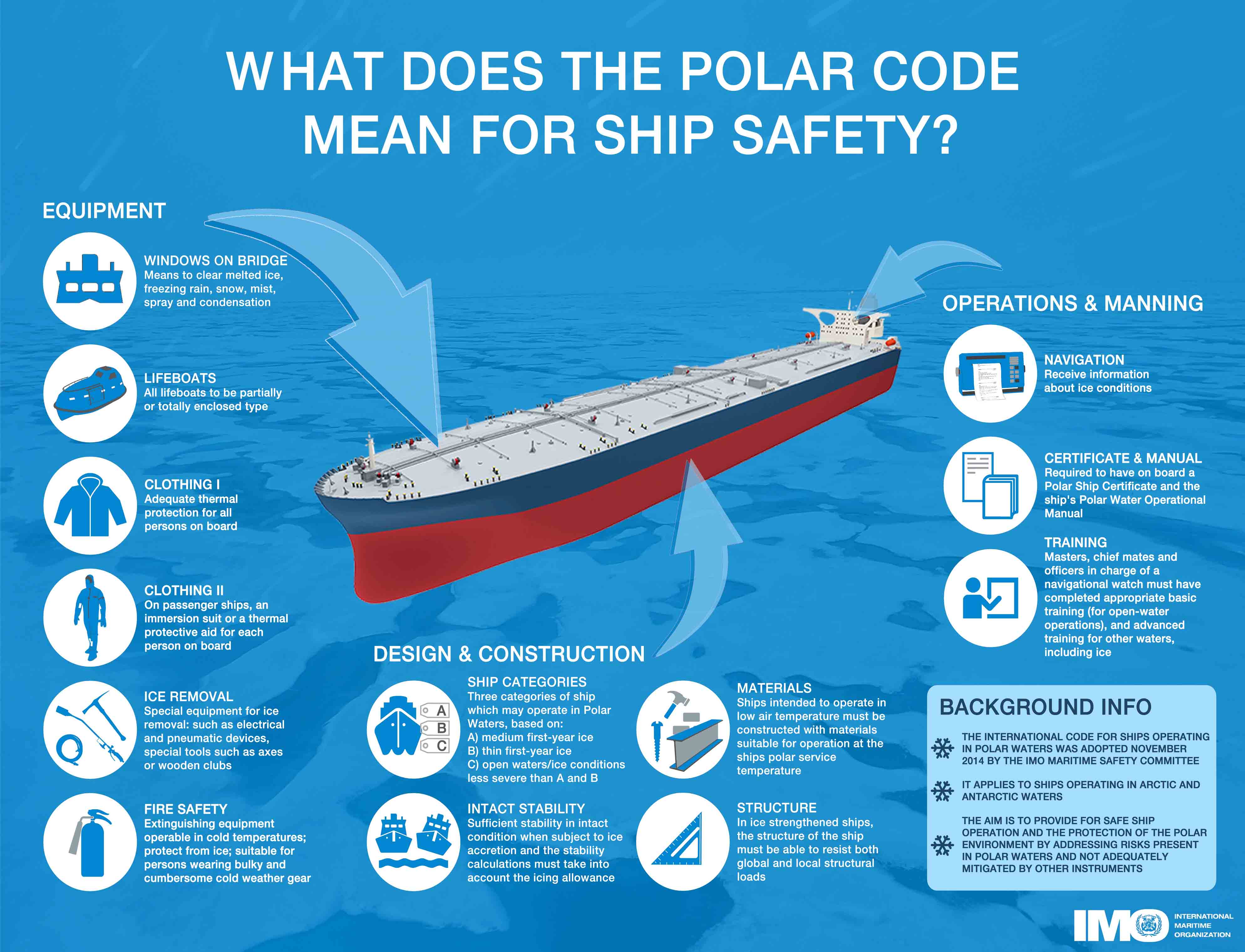 English |
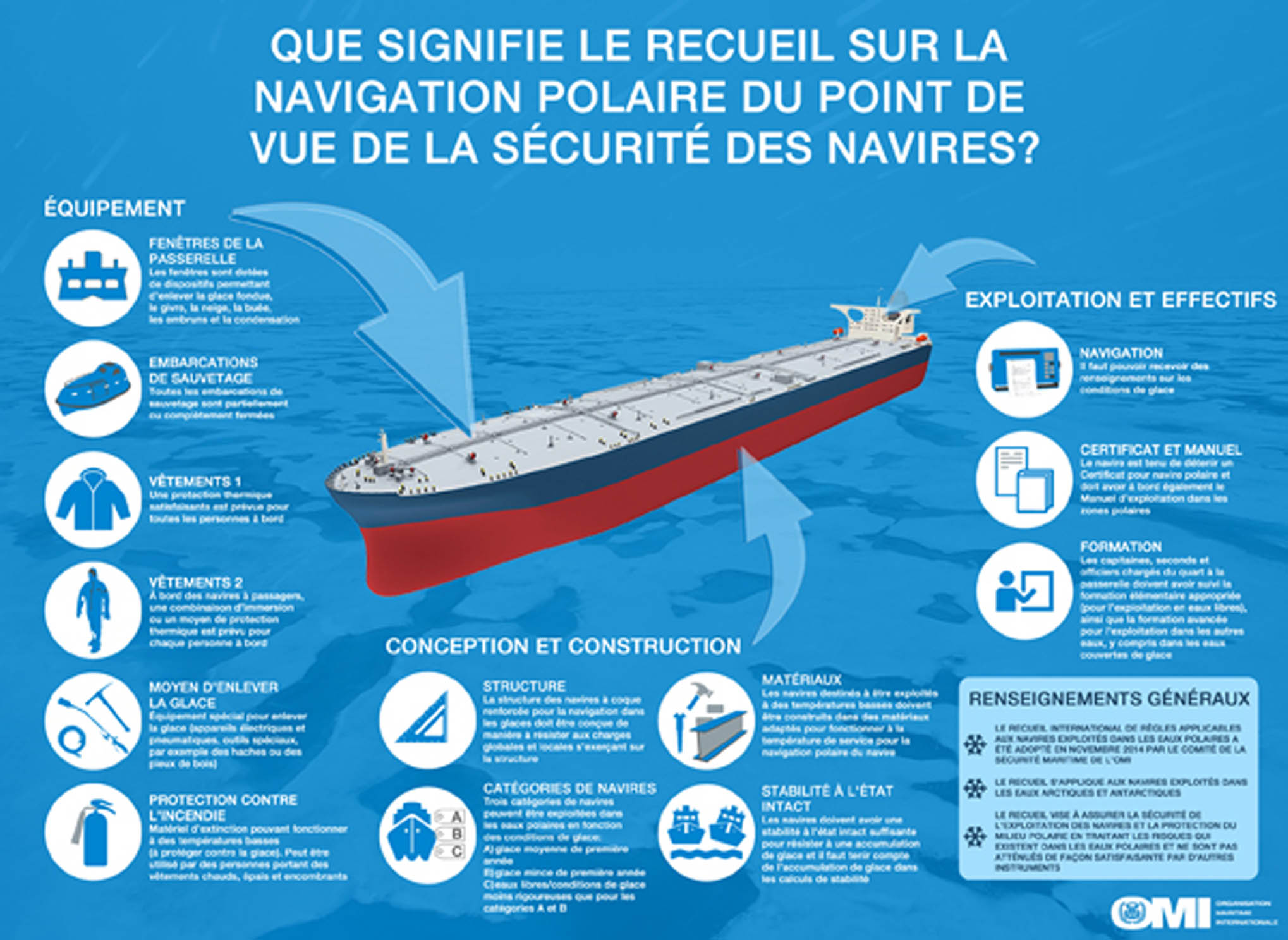 French |
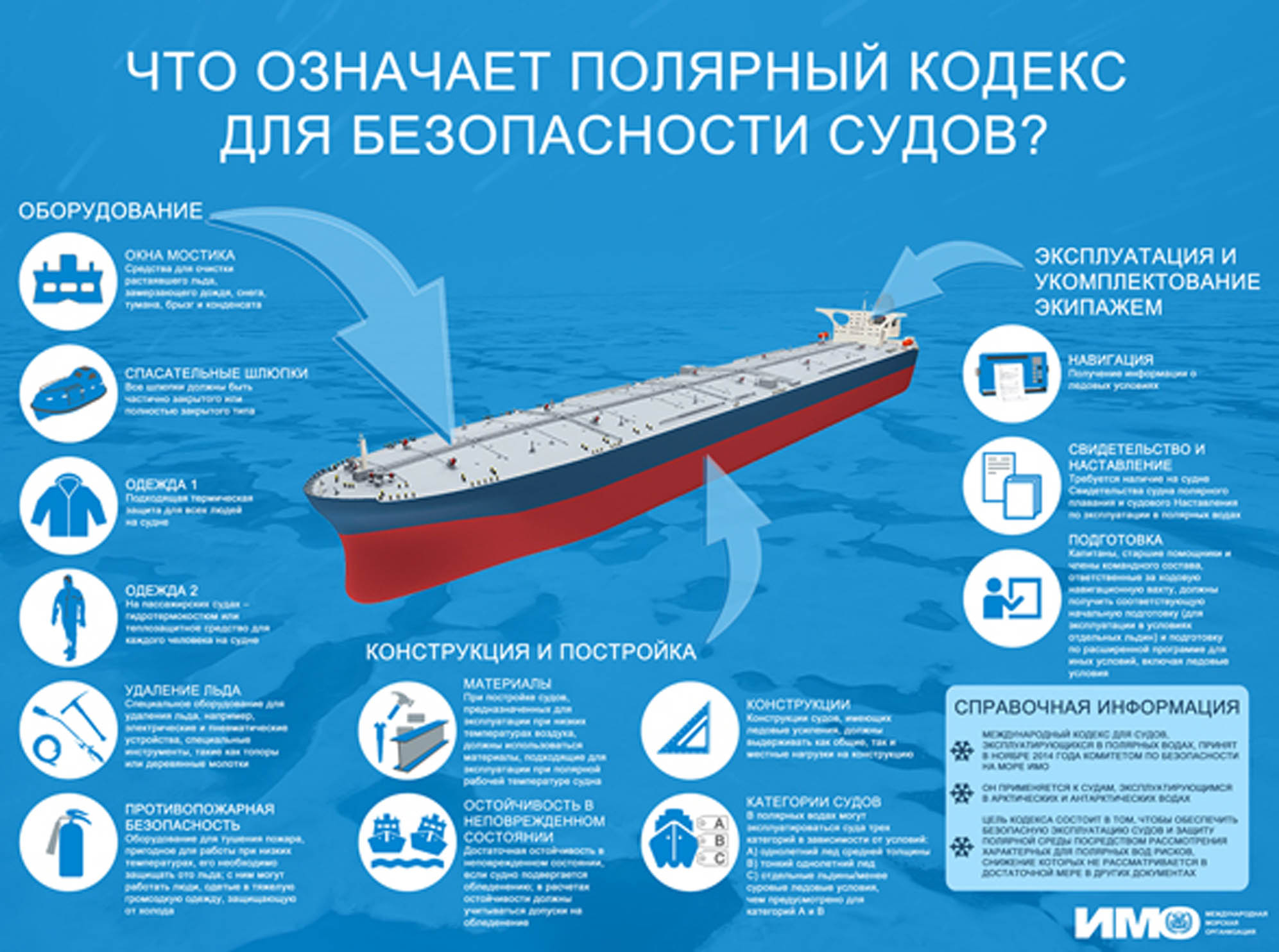 Russian |
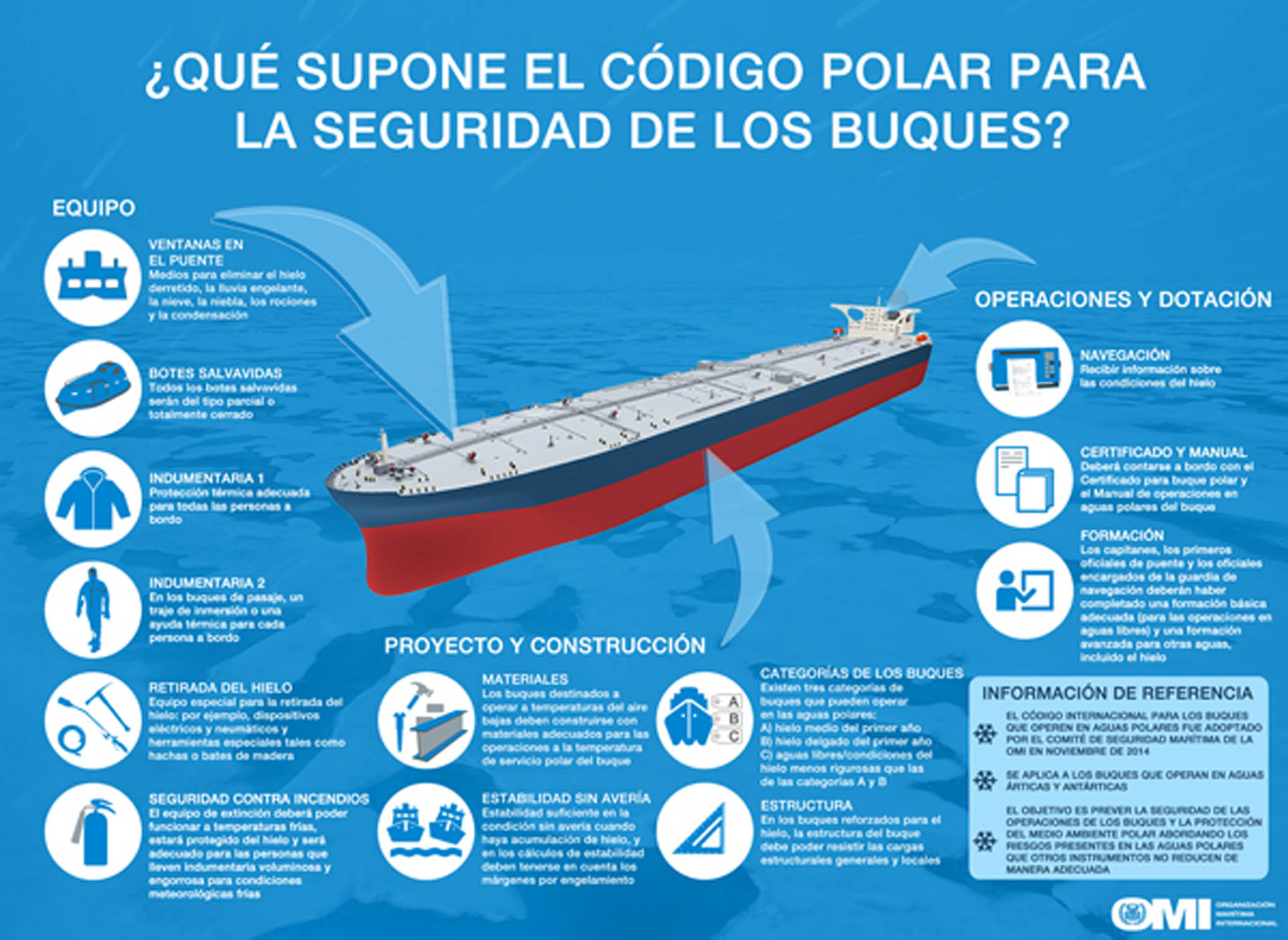 Spanish |
How does the Polar Code protect the environment?
The following infographic illustrates the environmental requirements of the Polar Code - available to view and download:
Polar Code Summary
The Polar Code (click for full text) is intended to cover the full range of shipping-related matters relevant to navigation in waters surrounding the two poles – ship design, construction and equipment; operational and training concerns; search and rescue; and, equally important, the protection of the unique environment and eco-systems of the polar regions.
The Polar Code includes mandatory measures covering safety part (part I-A) and pollution prevention (part II-A) and recommendatory provisions for both (parts I-B and II-B)..jpg)
The Code requires ships intending to operating in the defined waters of the Antarctic and Arctic to apply for a Polar Ship Certificate, which classifies the vessel as Category A ship - ships designed for operation in polar waters at least in medium first-year ice, which may include old ice inclusions; Category B ship - a ship not included in category A, designed for operation in polar waters in at least thin first-year ice, which may include old ice inclusions; or Category C ship - a ship designed to operate in open water or in ice conditions less severe than those included in Categories A and B.
The issuance of a certificate requires an assessment, taking into account the anticipated range of operating conditions and hazards the ship may encounter in the polar waters. The assessment includes information on identified operational limitations, and plans or procedures or additional safety equipment necessary to mitigate incidents with potential safety or environmental consequences.
Ships need to carry a Polar Water Operational Manual, to provide the Owner, Operator, Master and crew with sufficient information regarding the ship's operational capabilities and limitations in order to support their decision-making process.
The chapters in the Code each set out goals and functional requirements, to include those covering ship structure; stability and subdivision; watertight and weathertight integrity; machinery installations; operational safety; fire safety/protection; life-saving appliances and arrangements; safety of navigation; communications; voyage planning; manning and training; prevention of oil pollution; prevention of pollution form from noxious liquid substances from ships; prevention of pollution by sewage from ships; and prevention of pollution by discharge of garbage from ships.
Training requirements
Chapter 12 of the Polar Code on manning and training says that companies must ensure that masters, chief mates and officers in charge of a navigational watch on board ships operating in polar waters have completed appropriate training, taking into account the provisions of the International Convention on Standards of Training, Certification and Watchkeeping for Seafarers (STCW) and its related STCW Code.
Mandatory minimum requirements for the training and qualifications of masters and deck officers on ships operating in polar waters were also adopted by IMO’s Maritime Safety Committee in November 2016. They became mandatory under the STCW Convention and the STCW Code from 1 July 2018.
Background
The safety of ships operating in the harsh, remote and vulnerable polar areas and the protection of the pristine environments around the two poles have always been a matter of concern for IMO and many relevant requirements, provisions and recommendations have been developed over the years.
Trends and forecasts indicate that polar shipping will grow in volume and diversify in nature over the coming years and these challenges need to be met without compromising either safety of life at sea or the sustainability of the polar environments.
Ships operating in the Arctic and Antarctic environments are exposed to a number of unique risks. Poor weather conditions and the relative lack of good charts, communication systems and other navigational aids pose challenges for mariners. The remoteness of the areas makes rescue or clean-up operations difficult and costly. Cold temperatures may reduce the effectiveness of numerous components of the ship, ranging from deck machinery and emergency equipment to sea suctions. When ice is present, it can impose additional loads on the hull, propulsion system and appendages.
The International code of safety for ships operating in polar waters (Polar Code) covers the full range of design, construction, equipment, operational, training, search and rescue and environmental protection matters relevant to ships operating in the inhospitable waters surrounding the two poles.
.jpg)
The move to develop a mandatory Code followed the adoption by the IMO Assembly, in 2009, of Guidelines for ships operating in polar waters (resolution A.1024(26)), which are intended to address those additional provisions deemed necessary for consideration beyond existing requirements of the SOLAS and MARPOL Conventions, in order to take into account the climatic conditions of Polar waters and to meet appropriate standards of maritime safety and pollution prevention. The Guidelines are recommendatory.
Whilst Arctic and Antarctic waters have a number of similarities, there are also significant differences. The Arctic is an ocean surrounded by continents while the Antarctic is a continent surrounded by an ocean. The Antarctic sea ice retreats significantly during the summer season or is dispersed by permanent gyres in the two major seas of the Antarctic: the Weddell and the Ross. Thus there is relatively little multi-year ice in the Antarctic. Conversely, Arctic sea ice survives many summer seasons and there is a significant amount of multi-year ice. Whilst the marine environments of both Polar seas are similarly vulnerable, response to such challenge should duly take into account specific features of the legal and political regimes applicable to their respective marine spaces.
Protection of the Antarctic and Arctic from heavy grade oils
A MARPOL regulation, to protect the Antarctic from pollution by heavy grade oils, was adopted by the Marine Environment Protection Committee (MEPC), at its 60th session in March 2010. The amendments entered into force on 1 August 2011.
On 1 November 2022, amendments to MARPOL Annex I (addition of a new regulation 43A) entered into force, introducing a prohibition on the use and carriage for use as fuel of heavy fuel oil (HFO) by ships in Arctic waters on and after 1 July 2024. The prohibition covers the use and carriage for use as fuel of oils having a density at 15°C higher than 900 kg/m3 or a kinematic viscosity at 50°C higher than 180 mm2/s. Ships engaged in securing the safety of ships, or in search and rescue operations, and ships dedicated to oil spill preparedness and response are exempted. Ships which meet certain construction standards with regard to oil fuel tank protection need to comply on and after 1 July 2029. A Party to MARPOL with a coastline bordering Arctic waters may temporarily waive the requirements for ships flying its flag while operating in waters subject to that Party's sovereignty or jurisdiction, up to 1 July 2029.
In 2021, the MEPC adopted a resolution which urges Member States and ship operators to voluntarily use distillate or other cleaner alternative fuels or methods of propulsion that are safe for ships and could contribute to the reduction of Black Carbon emissions from ships when operating in or near the Arctic. The resolution encourages Member States to commence addressing the threat to the Arctic from Black Carbon emissions, and report on measures and best practices to reduce Black Carbon emissions from shipping.
In 2024, the MEPC issued Guidelines on mitigation measures to reduce risks of use and carriage for use of HFO as fuel by ships in Arctic waters.
Voyage planning in remote areas
The IMO Assembly in November 2007 adopted the Guidelines on voyage planning for passenger ships operating in remote areas (resolution A.999(25)), in response to the growing popularity of ocean travel for passengers and the desire for exotic destinations, which have led to increasing numbers of passenger ships operating in remote areas. When developing a plan for voyages to remote areas, special consideration should be given to the environmental nature of the area of operation, the limited resources, and navigational information.
The detailed voyage and passage plan should include the following factors: safe areas and no-go areas; surveyed marine corridors, if available; and contingency plans for emergencies in the event of limited support being available for assistance in areas remote from SAR facilities.
.jpg)
In addition, the detailed voyage and passage plan for ships operating in Arctic or Antarctic waters should include the following factors: conditions when it is not safe to enter areas containing ice or icebergs because of darkness, swell, fog and pressure ice; safe distance to icebergs; and presence of ice and icebergs, and safe speed in such areas.
Ship reporting in the Arctic region
At its 91st session in November 2012, MSC adopted a new mandatory ship reporting system "In the Barents Area (Barents SRS)" (proposed by Norway and the Russian Federation). The new mandatory ship reporting system entered into force at 0000 hours UTC on 1 June 2013. The following categories of ships passing through or proceeding to and from ports and anchorages in the Barents SRS area are required to participate in the ship reporting system, by reporting to either Vardø VTS centre or Murmansk VTS centre: all ships with a gross tonnage of 5,000 and above; all tankers; all ships carrying hazardous cargoes; a vessel towing when the length of the tow exceeds 200 metres; and any ship not under command, restricted in their ability to manoeuvre or having defective navigational aids.
Ship routeing in the Arctic
At its 99th session in May 2018, MSC adopted new and amended ships' routeing measures in the Bering Sea and Bering Strait, aimed at reducing the risks of incidents - the first measures adopted by IMO for the Arctic region where the Polar Code applies.
The measures include six two-way routes and six precautionary areas, to be voluntary for or all ships of 400 gross tonnage and above, in the Bering Sea and Bering Strait off the coast of the Chukotskiy Peninsula and Alaska, proposed by the Russian Federation and the United States. These waters are expected to see increased traffic due to rising economic activity in the Arctic.
In addition, MSC established three areas to be avoided in the Bering Sea, proposed by the United States, to improve safety of navigation and protect the fragile and unique environment. These measures entered into force on 1 December 2018.
Polar Code (second phase)
In 2023, IMO's Maritime Safety Committee (at MSC 107), adopted a first set of amendments to the Polar Code, together with associated amendments to the SOLAS Convention, to incorporate new requirements concerning safety of navigation and voyage planning, applicable to fishing vessels of 24 m in length overall and above, pleasure yachts of 300 GT and above not engaged in trade and cargo ships of 300 GT and above but below 500 GT, operating in polar waters. The amendments are expected to enter into force on 1 January 2026.
The amendments are applicable to fishing vessels of 24 m in length overall and above, pleasure yachts of 300 GT and upwards not engaged in trade, and cargo ships of 300 GT and upwards but below 500 GT. They aim to enhance the safety of ships operating under the special conditions the polar areas present, as well as that of the persons on board.
Currently the Polar Code is mandatory for certain ships under the SOLAS and MARPOL Conventions. While SOLAS Chapter V (Safety of navigation) applies to all ships on all voyages (with some specific exceptions), the other chapters of the Convention do not apply to non-SOLAS ships.
The IMO Assembly, meeting in November-December 2019, adopted an Assembly resolution urging Member States to implement, on a voluntary basis, safety measures of the Polar Code on ships not certified under the SOLAS Convention (Download resolution A.1137(31)).
IMO's Maritime Safety Committee, also in 2019 (MSC 101), approved guidance for navigation and communication equipment intended for use on ships operating in polar waters. The guidance includes recommendations on temperature and mechanical shock testing, and on how to address ice accretion and battery performance in cold temperatures.
Amendments to the Interim guidelines on life-saving appliances and arrangements for ships operating in polar waters (MSC.1/Circ.1614) were approved at MSC 106. The Interim Guidelines, initially approved in 2019, outline possible means of mitigating hazards in order to comply with the Polar Code and are intended to assist ship designers and shipowners/operators, as well as Administrations, in the uniform implementation of relevant provisions of the Polar Code, complementing existing requirements of the International Life-saving Appliance (LSA) Code.
The amendments to the Interim Guidelines introduce a methodology for the calculation of the maximum time of rescue, set out in an appendix, so that ships can find out how much supply, such as food rations and fresh water, and which type of equipment they should carry on board.
IMO/Canada training for seafarers operating in Polar waters
IMO and Transport Canada have signed a Memorandum of Understanding to deliver regional capacity-building workshops to provide training for trainers to deliver training programmes for seafarers operating in Polar waters and on the implementation of the Polar Code.
The project harnesses IMO's competence as the United Nations specialized agency responsible for setting global standards for the safety, security and facilitation of international shipping and the prevention of pollution by ships, in collaboration with Canada's financial support and expertise in supporting implementation of the Polar Code.
The regional train-the-trainer workshops aim to assist Governments and their maritime training institutes in enhancing the skills and competence of maritime instructors to develop competence-based training programmes, update existing programmes and improve the delivery of specific IMO model courses (Basic and Advanced training for ships operating in Polar waters).
The training is focused on how to implement IMO conventions dealing with ships operating in polar waters, especially the Polar Code and STCW Convention. It includes technical presentations, case studies and table-top exercises, simulations on navigation simulator, regional regulations and the required training and certification for seafarers on ships operating in polar waters.
Under the project, five regional capacity-building workshops were delivered between 2019 and 2022:
- 9 to 13 September 2019, in St. John's, Newfoundland, Canada
- 18 to 22 November 2019, in Valparaiso, Chile
- 22 to 26 November 2021, in the region coordinated by the Republic of Korea (eLearning/virtual)*
- 6 to 10 December 2021, in the region coordinated by the Russian Federation (eLearning/virtual)*
- 28 to 30 September and in-person from 3 to 5 October 2022, in Izmir, Türkiye (hybrid eLearning/in-person)
*Two workshops scheduled for March and June of 2020 were postponed for 2021 due to the COVID-19 pandemic. These were delivered online via IMO's Learning Management System (LMS).
In December 2023, an international workshop to review lessons learned over the course of this training programme was held in Argentina, engaging many delegates who had previously participated in the regional train-the-trainer workshops.
Stemming from this workshop, Argentina, along with co-sponsors Canada, Chile, Georgia, Malaysia, Philippines, South Africa and Türkiye, tabled 14 recommendations with the IMO’s Sub-Committee on Human Element, Training and Watchkeeping (HTW), with the aim of enhancing training programmes for seafarers who operate in polar waters.
